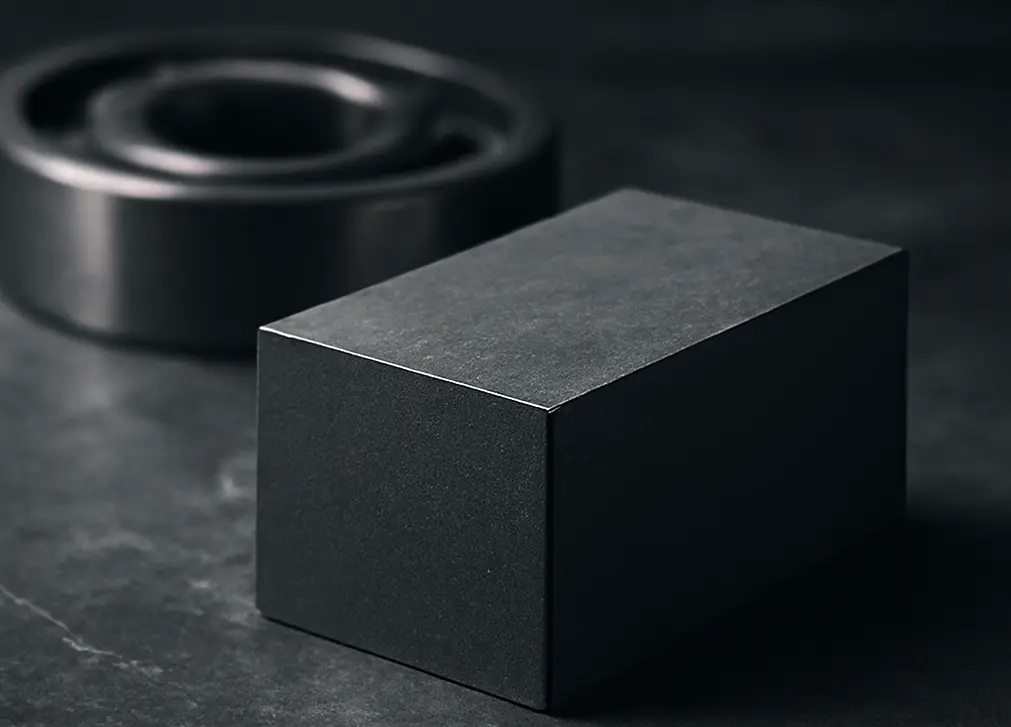
What Are Carbon Graphites?
Carbon graphites are produced when carbon bodies are heat-treated at temperatures below 1200°C, a process known as carbonization. Unlike electrographite, which undergoes higher temperature treatment, carbon graphites do not yet form a continuous graphite structure. Instead, they are characterized by:
- High strength and hardness
- Excellent wear resistance
- Outstanding sliding properties
- High dimensional stability, even under heat
- Smooth surface finish suitable for precision applications
These properties make carbon graphites ideal for many mechanical and electrical applications, where durability and performance are critical.
Where Are Carbon Graphites Used?
Seals and Bearings
- Widely applied in slide bearings, dynamic seals, and shaft seals.
- The material’s low wear and stable structure ensure long service life and reliable operation.
Glass Manufacturing
- Used as support blocks, transport pins, and other handling components.
- The smooth finish and heat resistance of carbon graphite make it ideal for the manufacture and transport of glass products.
Household Electrical Motors
- Essential for carbon brushes in motors for appliances such as washing machines and vacuum cleaners.
- Carbon graphite brushes provide:
- Extended service life
- Excellent electrical conductivity
- Reduced radio interference
- These features ensure efficiency, durability, and quieter performance in consumer appliances.
Why Choose Carbon Graphite?
- Durability – High wear resistance means longer service life.
- Performance – Reliable electrical conductivity and stable sliding performance.
- Versatility – Applicable across industries from household appliances to industrial sealing systems.
- Cost-Effectiveness – Extended lifetime reduces maintenance and downtime.
Conclusion
Carbon graphites combine strength, hardness, wear resistance, and electrical performance in one material. Whether used in seals, bearings, glass manufacturing, or carbon brushes for electrical motors, they play an essential role in both industrial processes and everyday household applications.
By choosing the right grade of carbon graphite, businesses can achieve higher efficiency, reduced costs, and improved reliability in their operations.
FAQ – Frequently asked questions about carbon graphite
What is carbon graphite?
Carbon graphite is an engineered material created by combining amorphous carbon and crystalline graphite. It combines the high mechanical strength of carbon with the excellent tribological properties of graphite and is used in a wide range of industrial applications.
What are the properties of carbon graphite?
Carbon graphite is characterized by high wear resistance, good sliding properties, dimensional stability at elevated temperatures, and low thermal conductivity. It is also chemically resistant and can be individually tailored—for example, through resin or metal impregnation—to meet specific application requirements.
What are the applications of carbon graphite?
Carbon graphite is used across numerous industrial sectors, including:
- Sealing rings and slide bearings for pumps and compressors
- Carbon brushes in electric motors and generators
- Components in the chemical, pharmaceutical, and food industries
- Parts for aerospace, energy, and environmental technology
Its versatile properties make it especially suitable for applications requiring high mechanical load capacity and resistance to extreme operating conditions.
How is carbon graphite manufactured?
The production of carbon graphite involves mixing carbon-based materials with binders, followed by a forming process such as pressing or extrusion. The material is then carbonized at high temperatures to achieve the desired characteristics. Depending on the intended use, additional processing steps such as impregnation or specialized heat treatments can be applied to further optimize material properties.

